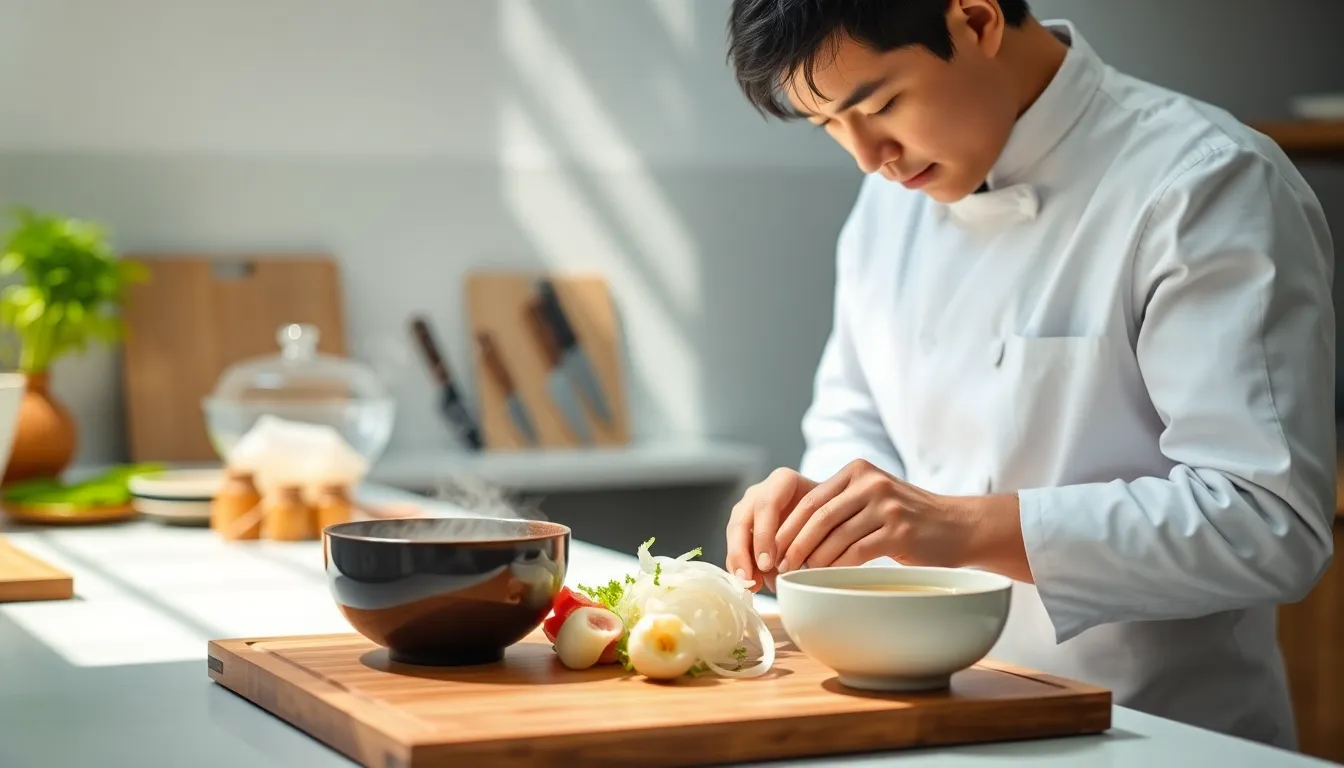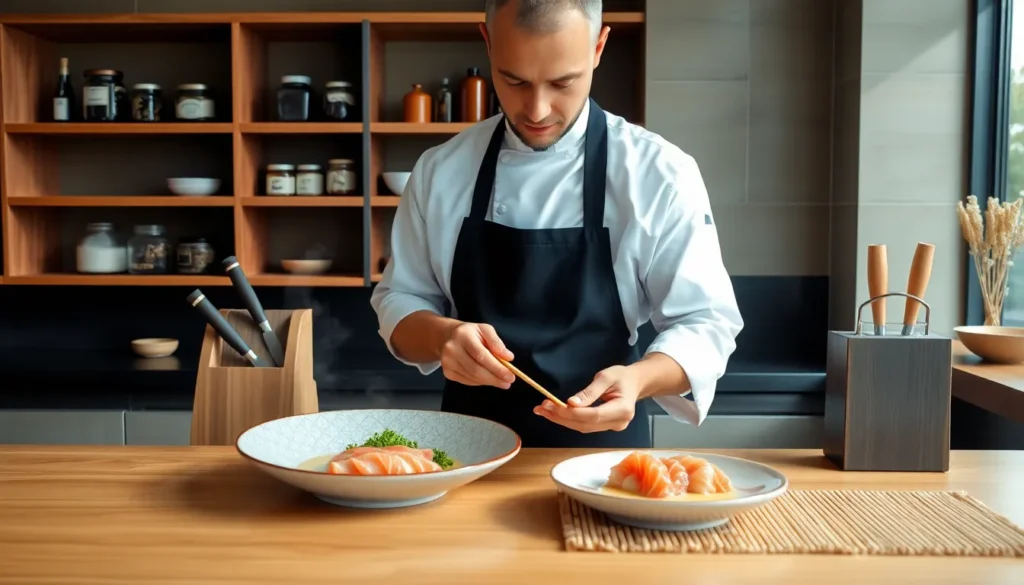Table of Contents
ToggleJapanese cooking is not just about food: it’s a harmonious blend of art, science, and a sprinkle of zen. From umami-rich broths to meticulously plated sashimi, the techniques that define this cuisine are both simple and complex. Ever tried to replicate that perfect sushi roll and ended up with a hot mess? Well, don’t worry: you’re not alone. Jump into the world of Japanese cooking techniques, where tradition meets modern flair, and discover how little tweaks can make a world of difference in your culinary prowess. Buckle up, foodies, the flavors of Japan are calling.
Understanding the Fundamentals of Japanese Cuisine

At its core, Japanese cuisine revolves around a few key principles: freshness, seasonal ingredients, and balance. Unlike some other cuisines that thrive on heavy spices, Japanese cooking emphasizes the natural flavors of high-quality ingredients. The concept of ‘umami,’ often described as the fifth taste, plays a significant role in crafting dishes. It’s that savory depth that makes a bowl of miso soup not just comforting but downright addictive.
The art of presentation is another crucial element. Dishes are often served to showcase the beauty of the ingredients. This philosophy, known as ‘mottainai,’ reflects a respect for the food itself, urging cooks to avoid waste, whether it be in flavor or aesthetics. When one understands these values, they can begin to appreciate the finesse required in Japanese culinary practices.
Key Ingredients in Japanese Cooking
Key ingredients are what truly set Japanese cooking apart. Rice is undoubtedly at the heart of many meals, it’s not just a side dish, but a mainstay that symbolizes purity and sustenance. Next up is soy sauce, a versatile condiment that brings depth and saltiness. Whether it’s a drizzle over sashimi or a splash in stir-fried vegetables, this fermented wonder elevates every bite.
Consider also dashi, a fundamental broth made from kelp and bonito flakes. It’s the secret behind that addictive umami flavor in soups and sauces. Another ingredient worth noting is miso, a fermented soybean paste that provides both flavor and nutrition. Finally, there’s wasabi, a fiery condiment that, when properly paired, enhances the entire dining experience. Each of these components serves as building blocks, weaving together the intricate tapestry of Japanese flavors.
Traditional Japanese Cooking Techniques
Delving into traditional Japanese cooking techniques reveals a treasure trove of methods that have been refined over generations. One such technique is ‘yakimono,’ which refers to grilled dishes often cooked over an open flame. This method not only seals in flavors but also infuses a delightful smokiness.
Another essential technique is ‘simmering’ or ‘nitsuke.’ This method involves slowly cooking ingredients in a seasoned broth, allowing flavors to meld beautifully. Think of the iconic ‘nikujaga,’ a comforting stew of meat and potatoes.
Then there’s ‘sushi,’ where precision reigns supreme. The art of sushi-making extends beyond just slicing fish and rolling rice. It requires understanding the seasonal availability of fish, the balance of flavors, and the perfect texture of the rice. Each component must come together seamlessly for an authentic experience.
Finally, we cannot overlook ‘fermentation’, a staple in Japanese cooking. It’s an age-old practice used to create staples like soy sauce, miso, and pickled vegetables, enhancing both flavor and nutritional value.
Contemporary Adaptations in Japanese Cooking
Contemporary Japanese cooking is a fascinating mix of tradition and innovation. Chefs are increasingly blending Asian flavors with Western techniques, creating dishes that surprise and delight the palate. For example, you might find sushi burritos becoming a trend, incorporating fresh vegetables and sauces in handheld forms.
Another notable trend is the rise of plant-based Japanese cuisine. With more awareness about health and sustainability, dishes that marry traditional cooking with vegan principles are emerging. Think ‘vegan ramen’ crafted from roast vegetables and a rich dashi alternative, delicious and better for the planet.
Fusion cuisine is not just limited to innovation: it often pays homage to the roots of ingredients. By using traditional Japanese spices in western meals, chefs find a unique balance that respects both culinary heritages.
Health Benefits of Japanese Cooking Techniques
Japanese cooking techniques, with their emphasis on fresh ingredients and mindful preparation, also come with a host of health benefits. Low in saturated fats and high in nutritional value, traditional dishes prioritize vegetables, fish, and grains over red meats and rich dairy products.
For instance, the dietary staples of rice, vegetables, and fish offer essential omega-3 fatty acids, vitamins, and minerals, promoting cardiovascular health and overall well-being. Fermented foods like miso and pickles provide probiotics, which are essential for gut health, supporting digestion and immunity.
Also, portion control is subtly woven into Japanese culture. Meals are often served in smaller, aesthetically pleasing portions that encourage mindful eating, helping individuals avoid overeating while savoring each bite.
Tips for Mastering Japanese Cooking at Home
As anyone who has tried their hand at cooking knows, practice makes perfect. To master Japanese cooking at home, start by investing in a few quality tools. A sharp knife, bamboo sushi mat, and good-quality rice cooker can make a significant difference in your cooking experience.
Don’t be afraid to experiment with ingredients you may not be familiar with. Seek out Asian markets for authentic supplies like nori, dashi, and mirin. Use online tutorials or classes to expand your skills, whether it’s mastering sushi rolling techniques or creating a mouthwatering ramen broth. Documentation of progress, through notes or even a cooking journal, can help track what you enjoy and where improvements are needed.
Eventually, patience is key. Japanese cooking values the journey of cooking, encouraging cooks to take their time and enjoy the process. So, don’t just focus on the destination, embrace the joy of culinary exploration.








